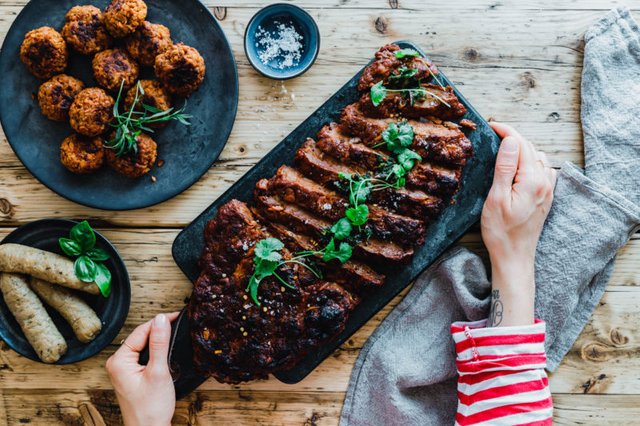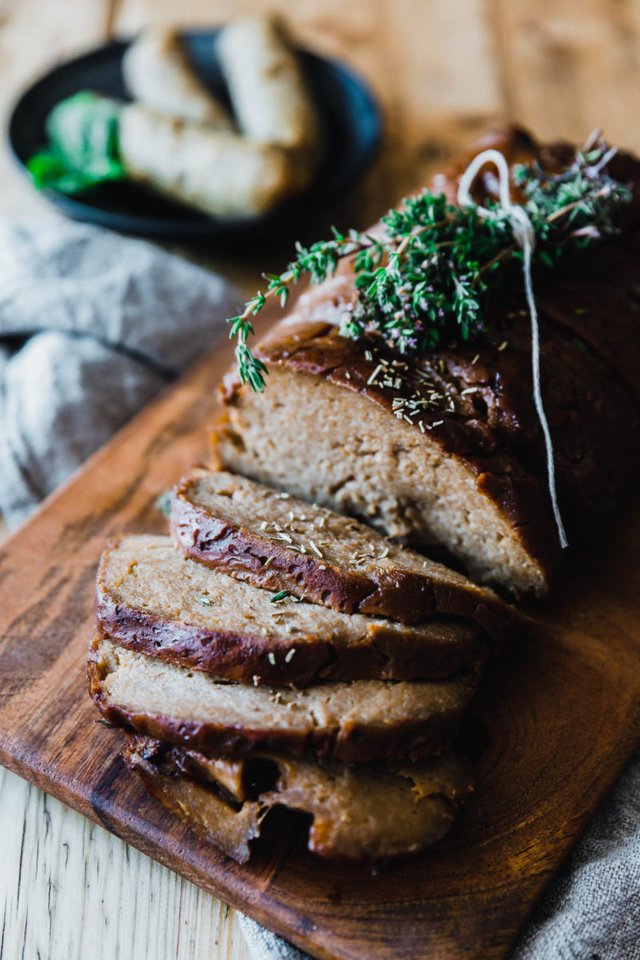Everything about seitan

The best vegan protein source? Fast.
Gluten contains a lot of protein. Damn much even. On 100 g and 75 g. It is not entirely coincidental, because we have already learned, it is traded to the sticky protein of the grain.
Now, I am different for seitan products, whether bought or homemade, of course, in their composition, pause you can not speak of a specific protein content. A relatively simple seitan made from gluten, water, spices and other ingredients that are not a good source of protein and juice. Tofu, tempeh and other soy products from ...
... but also meat.
Seitan would also be a good answer to the question where vegans get their protein at all. The thing has a little catch, because the protein profile lacks the essential amino acid lysine and the body can not even create.
Stupid? Just a bit.
It does not matter if the whole amino acid profile is in a particular food. However, friend and nutrition expert Niko Rittenau has just confirmed the much cited "balanced" diet. Otherwise, the lysine is increased, for example, over legumes.
Does that mean: Seitanaufschlag for breakfast and lentil stew in the evening? Watch out! Seitanwürstchen in lentil stew? Even better.
Cereal is a great food. To see that liquefying an amino acid profile, but it is still another place to eat legumes during the day to optimize the protein intake. This is how it succumbs to the individual proteins and is in no way inferior to some animal protein. This is twinning southern while is what is a myth.
Niko Rittenau, B.A. nutrition counseling
You can also "upgrade" the seitan, the amino acid profile was set. We mix in the future, chickpeas or flour from legumes in the seitanmasse. Originally, although it does change the consistency, it is also nice to improve the appreciation of the self-sufficient sausage.
Buy or do it yourself?
There are definitely very delicious finished products from and with seitan and we would never tell you that you should definitely keep your hands off it.
However, these products have been under continuous media fire for several years now. Too much salt, too much fat and therefore not as healthy as vegans like to imagine themselves.
In our opinion, that's a controversy. Hey, eating only finished products is never a good idea. No matter which nutritional form you follow. May one treat oneself to the supermarket shelves now and then? Absolute.
Still, DIY is always better and making Seitan yourself is not nearly as difficult as it may seem. And cheap yet. Gluten powder as a basic ingredient costs about 6 € per kilogram as a conventional product and about twice in organic quality. Spices and water? In the cost calculation actually almost negligible. In addition, a few cents for the energy used in the preparation. Bottom line: Great for the budget.
Theoretically, you just take wheat flour and wash the starch out under running water. Finished.
Let's put that "theoretically" and "easy" out of the sentence and you'll see me stand in front of the sink more than 10 years ago, as I'm very practical and not so easy to handle with a dough lump. Because yes, the washing out really works, but has two major disadvantages.
On the one hand you waste a lot of water, on the other hand, the production just takes a long time. Can you spend better. For example with a series "The End of the F *** ing World".
It is definitely easier with gluten powder or "seitan fix" as a basic ingredient. This also has the advantage that you can mix spices and other ingredients directly, while you can actually control the taste of washed seitan only about marinades.
Food
The raw pamp you stirred together is just as raw as bread dough is not yet edible. The raw material must be cooked before further processing - including roasting or grilling. And there are basically three options.
Boil in broth
It is often advised in preparation instructions to cook the seitan in a (very) vigorous broth. Although the seitan takes on a great deal of flavor from the brew, the taste of the spices, which are processed directly into the dough, is also slightly washed out. In our opinion, the consistency takes getting used to "spongy" and rather soft.
to bake
Baked seitan is in contrast to the cooked firm and is great for slicing. For almost everything else, however, the seitan in the oven becomes too tough.
dampen
Our favorite method. When steaming you drive so the perfect middle ground. The taste of the spices, which are already used in the preparation of the dough, remains intact and the seitan pieces are neither too soft, they dry out and become tough.
We simply use a large pot with matching steaming attachment, but of course you can also use a steamer.
Important: For all types of preparation, the seitan should then cool down urgently and, at best, be put in the fridge overnight. The consistency just gets better.
Consistency is everything
Where we are at the moment. The quality of home-made seitan stands and falls simply with the consistency.
As a rule of thumb, you can remember that the liquid you add to the dry ingredients should be about 60/40. This applies both to the preparation in the steam tower, as well as baked Seitanprodukte, which are already solid. Incidentally, the amount of liquid also includes ingredients such as beetroot or the legumes already mentioned, which are usually blended with the preparation.
And then there's the thing with the manual work (which you can happily hand over to a food processor).
For the seitan to get a good bite, it must be well kneaded. Strands are thus formed in the gluten, which then form the fiber-like consistency. But beware: Seitan can also be "kneaded". As is the case with bread, the rule of thumb is that you should work really hard for about 10 minutes. Or just press on the button of your food processor.
The final product is then molded. Sausages and cold cuts are wrapped in plenty of cling film or very strong "sandwich paper" and tied at the side with tight knots. Much helps here too, because due to the high moisture in the dough, it can quickly happen that the good sausages fly around the ears when steaming or at least burst open.
You can also roast. Here you can also fall back on a clean kitchen towel for reasons of waste prevention. Simply wrap, tie tight and off into the steaming attachment.
With Geschnetzeltem and chunks for skewers, I save the wrapping completely. Again, it is an advantage if you already have bread baking experience. The dough is shaped and then folded several times inwards. So you provide a great surface tension that makes for a slightly nicer end result.
The right spice
You can mix it with basic spices that bring umami into the mix, such as soy sauce, miso, yeast flakes or tomato paste. Dried herbs? Spices? Always in it. It always makes sense to mix dry ingredients directly under the gluten powder and add liquid seasoning to the water used to stir the dough. So nothing clumps and everything is distributed evenly.
By the way, Seitan also takes good marinades. So there's nothing wrong with preparing a basic recipe and then marinating it to your liking.
durability
Check my recipes about seitan and the rest there all delicious
https://steemit.com/cooking/@batoananda/seitan-simple-basic-recipe
https://steemit.com/cooking/@batoananda/vegan-mountainkings-dumplings
https://steemit.com/cooking/@batoananda/seitan-sausage-vegan-bratwurst
https://steemit.com/cooking/@batoananda/seitangeschnetzeltes-chicken-style
